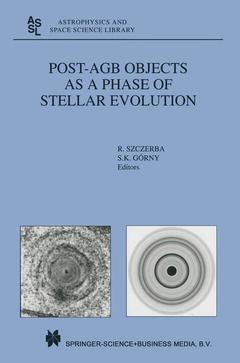Post-AGB Objects as a Phase of Stellar Evolution, 2001 Astrophysics and Space Science Library Series, Vol. 265
Langue : Anglais
Coordonnateurs : Szczerba R., Górny S.K.

The term proto-planetary nebulae (PPNe) in the context of the late stages of stellar evolution was created only slightly more than 20 years ago to express the belief that in the near future these objects will become planetary nebulae (PNe). The first proto-planetary nebulae (called also post-Asymptotic Giant Branch, or shortly post-AGB objects) AFGL 2688 and AFGL 618 were discovered in mid seventies in course of the Air Force Sky Survey. Investigation of this phase of stellar evolution developed very rapidly in 1980's after the IRAS mission when it became clear that proto-planetary nebulae emit a significant part of their energy in the mid-and far-infrared. Hundreds of new candidates have been proposed but the recognition of the real proto-planetary nebulae is not a simple task and needs a substantial effort to exclude cases that represent different evolutionary stages. High resolution spectroscopy of stellar atmospheres is of much importance in this respect. Surprisingly, only a small group of central stars, the so called 21 11m emitters, show chemical signatures of the 3 rd dredge up process. Very recently, a more detailed studies of mid-infrared spectra from the Infrared Space Observatory (ISO) allow for a better understanding of chemical composition and evolution of circumstellar material around these stars. A new impetus in the field of proto-planetary nebulae research was started in the 1990's with high spatial resolution imaging in mid-infrared and optical wavelength ranges.
Proto-planetary Nebulae as a Phase of Stellar Evolution.- Observational Database and Statistical Properties of Proto—planetary Nebulae.- Optical Survey of Post-AGB Candidates.- Hot Post-AGB Stars.- Properties of Post-AGB Stars with IRAS Colors Typical of Planetary Nebulae.- BVRIJHK Photometry of Post-AGB Candidates: Evolution of Post-AGB Central Stars.- Near IR Observations of the Arecibo Sample of OH/IR Stars.- HST Imaging of Proto-planetary Nebulae and Very Young Planetary Nebulae — Towards a New Understanding of Their Formation.- Morphological Properties of PPNs: Mid-IR and HST Imaging Surveys.- MSX Sources in the LMC: Dust-enshrouded AGB Stars and Post-AGB Stars.- Post-AGB Stars in Globular Clusters and Galactic Halos.- The Evolution of AGB Stars Towards Planetary Nebulae.- Mass Loss Characteristics of Dust Forming Long-Period Variable Stars.- Pulsations in Proto-Planetary Nebulae as seen From Light Curve Studies.- Atmospheric Dynamics of Post-AGB Stars: New Results on the Nature of the Pulsation of HD 56126.- Light Variability of Color Selected IRAS Sources: Variables in Late AGB and Early Post-AGB Phase.- Circumstellar Arcs in AGB and Post-AGB Stars.- Simulations of Quasi-Periodic Shells in Dust Forming AGB Winds.- Polarimetry and Direct Imaging of Detached Shells Around Carbon Stars.- Evolution of Thin Gas Shells Along the AGB and Beyond.- Modelling of the Observed Post-AGB Evolution.- The Effect of the Transition Times in the Formation of Planetary Nebulae.- Are Microstructures in the Outer Shells of PNe Fossil Condensations of the AGB Wind?.- The Infrared [WC] Stars.- Analysis of 5 PN with [WC 8–11] Nuclei.- Masses of Central Stars of Planetary Nebulae.- AGB Evolution in Binary Systems.- Planets and Axisymmetric Mass Loss.- Bipolar Outflows from OH/IRStars.- The Shape and Shaping of Proto-Planetary Nebulae.- SPH Models of Proto-Planetary Nebulae.- Dynamics of the Collimated Outflows of the PPN Hen 3-1475.- Strong Asymmetries in the Neutral Envelope of Mira.- Mass Loss Geometry in Symbiotic Binaries.- Circumstellar Environment of RX Puppis.- The Sudden Loss of 0.01 M? from the VV Cep’s Primary as a Characteristic of AGB Evolution in the Binaries.- AGB and Post-AGB Evolution: Structural and Chemical Changes.- Stellar Evolution and Nucleosynthesis of Post-AGB Stars.- What Can we Learn from Post-AGB Chemical Studies on the AGB 3rd Dredge-Up Phenomena?.- Optical Spectroscopy of Peculiar Supergiants.- Spectroscopical Masses of Post—AGB Stars.- BD+33°2642: Abundance Patterns in the Central Star of a Halo PN.- The Very Lithium Rich Post-AGB SB2 Binary HD 172481.- CIT 6: the Early Phase of PPN?.- Spectroscopy of Post-AGB A-Supergiant HD 101584 (IRAS 11385-5517).- Spectroscopy of Post-AGB Candidate HD 331319 (IRAS 19475+3119).- Spectroscopy of Post-AGB Candidate IRAS 10215-5916.- Spectroscopy of HD 168625 (IRAS 18184-1623).- The Evolutionary Status of HD 179821.- IRAS 01005+7910, a High Galactic Latitude Post-AGB Star?.- ISO Results for Protoplanetary Nebulae.- An Atlas of ISO SWS Spectra: The Transition from AGB Stars to PNe.- Big, Bumpy Dust Shells around Protoplanetary Nebulae.- Spatial Distributions of Multiple Dust Components in the PPN/PN Dust Shells.- Structure and Properties of IRC+10216.- Spatially Resolved Spectra of the Red Rectangle in the N-band.- Molecules in AGB (and Post-AGB) Circumstellar Envelopes.- Molecular Gas Images of Proto-planetary Nebulae.- H2 Spectroscopy of Protoplanetary Nebulae.- Molecular Hydrogen Around Post — AGB Stars.- Morphology and Kinematics of the Egg Nebula: CO and H2.-O-bearing Molecules in Carbon-rich Proto-planetary Objects: Study of CRL 618.- Low-excitation Atomic Gas Around Evolved Stars: ISO Observations of C-rich Nebulae.- Low-excitation Atomic Gas in PPNe: ISO Observations of FIR Line Emission in O-rich Objects.- Probing the Post-AGB Nature of HD 179821.- Masers Diagnostics to Identify Stars Departing from the AGB.- IRAS 18455+0448: The Birth and Death of OH/IR Stars.- OH Maser Mapping of Post-AGB Stars.- The Time Variation in the Water Vapor Bands in Oxygen-rich Mira Variables.- Further Detections of OH Masers in Carbon Stars with Silicate Features.- Object Index.- Author Index.
Date de parution : 12-2010
Ouvrage de 448 p.
16x24 cm
Date de parution : 08-2001
Ouvrage de 448 p.
15.5x23.5 cm
Thème de Post-AGB Objects as a Phase of Stellar Evolution :
Mots-clés :
photometry; planet; smoothed-particle hydrodynamics (SPH); spectroscopy; stars; stellar; stellar evolution
© 2024 LAVOISIER S.A.S.



